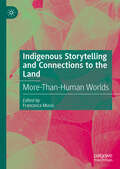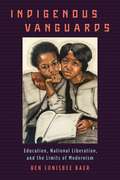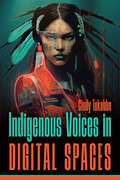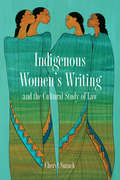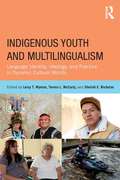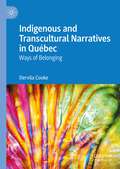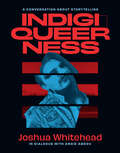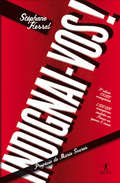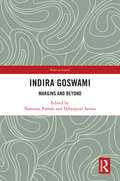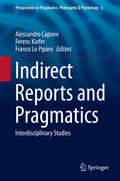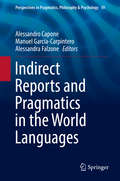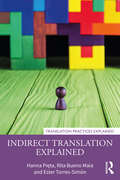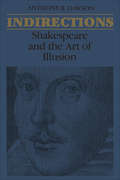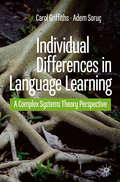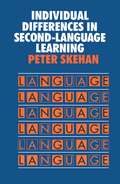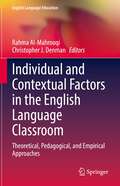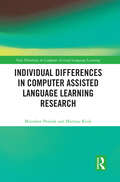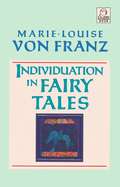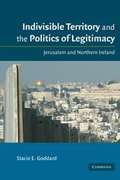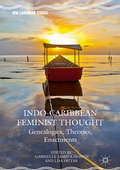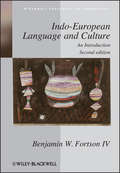- Table View
- List View
Indigenous Plots in Twenty-First Century Latin American Cinema
by Maria Chiara D'ArgenioIn this engaging book, Maria Chiara D’Argenio delineates a turn in recent Latin American filmmaking towards inter/cultural feature films made by non-Indigenous directors. Aimed at a global audience, but played by Indigenous actors, these films tell Indigenous stories in Indigenous languages. Over the last two decades, a growing number of Latin American films have screened the Indigenous experience by combining the local and the global in a way that has proved appealing at international film festivals. Locating the films in composite webs of past and present traditions and forms, Indigenous Plots in Twenty-First Century Latin American Cinema examines the critical reflection offered by recent inter/cultural films and the socio-cultural impact, if any, they might have had. Through the analysis of a selection of films produced between 2006 and 2019, the book gauges the extent to which non-Indigenous directors who set out to engage critically with colonial legacies and imaginaries, as well as with contemporary Indigenous marginalization, succeed in addressing these concerns by ‘unthinking’ and ‘undoing’ Western centrism and coloniality. Drawing on a wide range of disciplines and considering the entire cinematic process – from pre-production to the films’ production, circulation and critical reception – Indigenous Plots in Twenty-First Century Latin American Cinema makes the case for a holistic cultural criticism to explain the cultural and political work cinema does in specific historical contexts.
Indigenous Storytelling and Connections to the Land: More-Than-Human Worlds
by Francesca MussiThis book builds on the perspective that, for Indigenous peoples, relations to the land are familial, intimate, intergenerational, spiritual, instructive, and life nourishing, and it is these relations that Western societies sought to destroy as part of their colonial projects of territorial conquest and exploitation of resources. Positioning storytelling as a research methodology and a model of decolonial practice, this edited collection seeks to explore the following key questions: how does Indigenous storytelling contribute to understanding Indigenous identity and the crucial role of the land in Indigenous ways of life? How can Indigenous storytelling subvert colonial narratives of the land? How can Indigenous storytelling contribute to addressing colonial exploitations of the land and its resources? Can Indigenous storytelling become a rich mode for the investigation of current climate crises? And, finally, how does storytelling assist Indigenous peoples in restoring their intimate relations to the land and its natural gifts? Through critical analysis of a unique range of Indigenous storytelling practices, including fiction, performative art, new media platforms, archaeological findings and personal live-experienced stories, this collection aims to examine the interplay between colonialism and current environmental challenges, and to expose the impacts – past, present, and future – of Western worldviews on Indigenous connections to the land, whilst simultaneously bringing to the fore Indigenous ethos of care and land custodianship.
Indigenous Vanguards: Education, National Liberation, and the Limits of Modernism (Modernist Latitudes)
by Ben Conisbee BaerAnticolonial struggles of the interwar epoch were haunted by the question of how to construct an educational practice for all future citizens of postcolonial states. In what ways, vanguard intellectuals asked, would citizens from diverse subaltern situations be equally enabled to participate in a nonimperial society and world? In circumstances of cultural and social crisis imposed by colonialism, these vanguards sought to refashion modern structures and technologies of public education by actively relating them to residual indigenous collective forms.In Indigenous Vanguards, Ben Conisbee Baer provides a theoretical and historical account of literary engagements with structures and representations of public teaching and learning by cultural vanguards in the colonial world from the 1920s to the 1940s. He shows how modernizing educative projects existed in complex tension with impulses to indigenize national liberation movements, and how this tension manifests as a central aspect of modernist literary practice. Offering new readings of figures such as Alain Locke, Léopold Senghor, Aimé Césaire, D. H. Lawrence, Rabindranath Tagore, Mahatma Gandhi, and Tarashankar Bandyopadhyay, Baer discloses the limits and openings of modernist representations as they attempt to reach below the fissures of class that produce them. Establishing unexpected connections between languages and regions, Indigenous Vanguards is the first study of modernism and colonialism that encompasses the decisive way public education transformed modernist aesthetics and vanguard politics.
Indigenous Voices in Digital Spaces
by Cindy TekobbeIndigenous Voices in Digital Spaces applies Indigenous frameworks and epistemologies to online cultural movements through four case studies, including hashtags, memes, cryptocurrency, and digital artistry, and develops decolonizing practices for digital rhetoric, online identity work, and digital literacy practices. Tekobbe’s methods for analyzing and understanding Indigenous knowledges online center Indigenous storytelling and “thick” (broad, deep, and complex) Indigenous meaning-making. Employing this thickness to interpret Indigenous knowledge ways resists the settler-colonial logics that tend to flatten complex Indigenous concepts into one-note representations of racial stereotypes. Native Americans’ use of social media and digital platforms to support social movements uniquely constructs Indigenous identities as living, producing, and culture-making people, which confronts the commonplace, one-dimensional narrative that Indigenous North Americans either live in isolation or are people of history resigned to the long-forgotten past. Tekobbe’s methods are applicable to additional online research to break through Western paradigms of oppositional critique, the colonial power matrix embedded in hierarchical and taxonomical classification systems, and participant objectification. Indigenous Voices in Digital Spaces offers new methodological and epistemological opportunities to explore digital communities and technologies, problematizing conventional Western critique. This book is useful to instructors in Indigenous studies, internet studies, digital literacies, cultural studies, and communications, as well as Indigenous and internet studies researchers.
Indigenous Women's Writing and the Cultural Study of Law
by Cheryl SuzackIn Indigenous Women’s Writing and the Cultural Study of Law, Cheryl Suzack explores Indigenous women’s writing in the post-civil rights period through close-reading analysis of major texts by Leslie Marmon Silko, Beatrice Culleton Mosionier, Louise Erdrich, and Winona LaDuke. Working within a transnational framework that compares multiple tribal national contexts and U.S.-Canadian settler colonialism, Suzack sheds light on how these Indigenous writers use storytelling to engage in social justice activism by contesting discriminatory tribal membership codes, critiquing the dispossession of Indigenous women from their children, challenging dehumanizing blood quantum codes, and protesting colonial forms of land dispossession. Each chapter in this volume aligns a court case with a literary text to show how literature contributes to self-determination struggles. Situated at the intersections of critical race, Indigenous feminist, and social justice theories, Indigenous Women’s Writing and the Cultural Study of Law crafts an Indigenous-feminist literary model in order to demonstrate how Indigenous women respond to the narrow vision of law by recuperating other relationships–to themselves, the land, the community, and the settler-nation.
Indigenous Youth and Multilingualism: Language Identity, Ideology, and Practice in Dynamic Cultural Worlds
by Teresa L. McCarty Leisy T. Wyman Sheilah E. NicholasBridging the fields of youth studies and language planning and policy, this book takes a close, nuanced look at Indigenous youth bi/multilingualism across diverse cultural and linguistic settings, drawing out comparisons, contrasts, and important implications for language planning and policy and for projects designed to curtail language loss. Indigenous and non-Indigenous scholars with longstanding ties to language planning efforts in diverse Indigenous communities examine language policy and planning as de facto and de jure – as covert and overt, bottom-up and top-down. This approach illuminates crosscutting themes of language identity and ideology, cultural conflict, and linguistic human rights as youth negotiate these issues within rapidly changing sociolinguistic contexts. A distinctive feature of the book is its chapters and commentaries by Indigenous scholars writing about their own communities. This landmark volume stands alone in offering a look at diverse Indigenous youth in multiple endangered language communities, new theoretical, empirical, and methodological insights, and lessons for intergenerational language planning in dynamic sociocultural contexts.
Indigenous and Transcultural Narratives in Québec: Ways of Belonging
by Dervila CookeThis book focuses on modes of cultural belonging in Québec. It looks at recent literary memoir, autobiographical fiction, and documentary testimony. Through four in-depth case studies of cultural creators, one Indigenous and three non-Indigenous, Dervila Cooke discusses multicultural and ethnically diverse society in Québec, examining current tensions, challenges, and opportunities. Works studied range from Abla Farhoud’s first novel in 1998 to Anita Aloisio’s 2022 documentary film Calliari, QC. Topics include the desire for freedom to self-ascribe and enact cultural identity, self-reinvention through fiction, expressions of Indigeneity in Naomi Fontaine, the term “Québécois”, especially after Bill 21, and the thorny question of integration of immigrants, discussed in relation to Akos Verboczy’s Rhapsodie québécoise. As with the companion volume on France, societal factors are discussed, here relating to the cultural renaissance of Indigenous writing, Farhoud’s Libano-Québécois context, and language laws in Québec, including the foundational Bill 101 and the more recent Bill 96.
Indigiqueerness: A Conversation about Storytelling
by Joshua WhiteheadEvolving from a conversation between Joshua Whitehead and Angie Abdou, Indigiqueerness is part dialogue, part collage, and part memoir. Beginning with memories of his childhood poetry and prose and travelling through the library of his life, Whitehead contemplates the role of theory, Indigenous language, queerness, and fantastical worlds in all his artistic pursuits. This volume is imbued with Whitehead’s energy and celebrates Indigenous writers and creators who defy expectations and transcend genres.
Indignai-vos
by Stéphane Hessel1.500.000 exemplares vendidos em França em apenas 5 meses. «Um pequeno grande livro, com ideias inovadoras e críticas certeiras»Mário Soares «A minha longa vida deu me uma série de motivos para me indignar.» Quem o escreve é Stéphane Hessel, herói da Resistência francesa, sobrevivente dos campos de concentração nazis e um dos redactores da Declaração Universal dos Direitos Humanos. É com a autoridade moral de um resistente inconformado e de um lutador visionário que Stéphane Hessel nos alerta, neste breve manifesto, para o facto de existirem hoje tantos e tão sérios motivos para a indignação como no tempo em que o nacional-socialismo ameaçava o mundo livre. Se procurarmos, certamente encontraremos razões para a indignação: o fosso crescente entre muito pobres e muito ricos, o estado do planeta, o desrespeito pelos imigrantes e pelos direitos humanos, a ditadura intolerável dos mercados financeiros, a injustiça social, entre tantos outros. Aceitemos o desafio de Stéphane Hessel, procurando neste livro e no mundo que nos rodeia os motivos para a insurreição pacífica, pois «cabe-nos a todos em conjunto zelar para que a nossa sociedade se mantenha uma sociedade da qual nos orgulhemos».
Indira Goswami: Margins and Beyond (Writer in Context)
by Namrata Pathak and Dibyajyoti SarmaThis book engages with the life and works of Indira Goswami, the first Assamese woman writer to win the highest national literary award, the Jnanpith, in 2001. From sociological treatises to a springboard of a socio-political milieu, Goswami’s texts are intersections of the local and the global, the popular and the canonical. The writer’s penchant for transcending boundaries gives a new contour and shape to the social and cultural domains in her texts. That every character is a representative of the society, that the context comes alive in every evocation of class struggle, power play, caste discrimination and gendered narratives add an interesting semantic load to her texts. While tracing the trajectories discussed above, this book foregrounds Goswami’s act of going beyond the margins of varied kinds, both abstract and concrete, in search of egalitarian and democratic spaces of life. The book looks at Indira Goswami’s works with a special emphasis on the author situated within the Assamese literary canon. It not only discusses the themes and issues within her writing, but also focuses on the distinct language and style she uses. The volume includes non-fictional prose, excerpts from her short stories and novels, viewpoints of critics, letters and entries from diaries, as well as interviews with Goswami about her writing and personal life. It engages with her works in the context of her multifaceted, almost mythical life, especially her avowed ‘activism’ against animal sacrifice and militancy in her latter career. Part of the Writer in Context series, this book will be useful for scholars and researchers of Indian literature, Assamese literature, English literature, postcolonial studies, cultural studies, global south studies, gender studies, and translation studies.
Indira Goswami: Margins and Beyond (Writer in Context)
by Namrata Pathak and Dibyajyoti SarmaThis book engages with the life and works of Indira Goswami, the first Assamese woman writer to win the highest national literary award, the Jnanpith Award, in 2001. From sociological treatises to a springboard of a socio-political milieu, Goswami’s texts are intersections of the local and the global, the popular and the canonical. The writer’s penchant for transcending boundaries gives a new contour and shape to the social and cultural domains in her texts. That every character is a representative of the society, that the context comes alive in every evocation of class struggle, power play, caste discrimination and gendered narratives add an interesting semantic load to her texts. While tracing the trajectories discussed above, this book foregrounds Goswami’s act of going beyond the margins of varied kinds, both abstract and concrete, in search of egalitarian and democratic spaces of life.The book looks at Indira Goswami’s works with a special emphasis on the author situated within the Assamese literary canon. It not only discusses the themes and issues within her writing, but also focuses on the distinct language and style she uses. The volume includes non-fictional prose, excerpts from her short stories and novels, viewpoints of critics, letters and entries from diaries, as well as interviews with Goswami about her writing and personal life. It engages with her works in the context of her multifaceted, almost mythical life, especially her avowed ‘activism’ against animal sacrifice and militancy in her latter career.Part of the Writer in Context series, this book will be useful for scholars and researchers of Indian literature, Assamese literature, English literature, postcolonial studies, cultural studies, global south studies, gender studies and translation studies.
Indirect Reports and Pragmatics
by Alessandro Capone Franco Lo Piparo Ferenc KieferThis volume offers the reader a singular overview of current thinking on indirect reports. The contributors are eminent researchers from the fields of philosophy of language, theoretical linguistics and communication theory, who answer questions on this important issue. This exciting area of controversy has until now mostly been treated from the viewpoint of philosophy. This volume adds the views from semantics, conversation analysis and sociolinguistics. Authors address matters such as the issue of semantic minimalism vs. radical contextualism, the attribution of responsibility for the modes of presentation associated with Noun Phrases and how to distinguish the indirect reporter's responsibility from the original speaker's responsibility. They also explore the connection between indirect reporting and direct quoting. Clearly indirect reporting has some bearing on the semantics/pragmatics debate, however, there is much controversy on "what is said", whether this is a minimal semantic logical form (enriched by saturating pronominals) or a much richer and fully contextualized logical form. This issue will be discussed from several angles. Many of the authors are contextualists and the discussion brings out the need to take context into account when one deals with indirect reports, both the context of the original utterance and the context of the report. It is interesting to see how rich cues and clues can radically transform the reported message, assigning illocutionary force and how they can be mobilized to distinguish several voices in the utterance. Decoupling the voice of the reporting speaker from that of the reported speaker on the basis of rich contextual clues is an important issue that pragmatic theory has to tackle. Articles on the issue of slurs will bring new light to the issue of decoupling responsibility in indirect reporting, while others are theoretically oriented and deal with deep problems in philosophy and epistemology.
Indirect Reports and Pragmatics in the World Languages (Perspectives in Pragmatics, Philosophy & Psychology #19)
by Alessandro Capone Alessandra Falzone Manuel García-CarpinteroThis volume addresses the intriguing issue of indirect reports from an interdisciplinary perspective. The contributors include philosophers, theoretical linguists, socio-pragmaticians, and cognitive scientists. The book is divided into four sections following the provenance of the authors. Combining the voices from leading and emerging authors in the field, it offers a detailed picture of indirect reports in the world’s languages and their significance for theoretical linguistics. Building on the previous book on indirect reports in this series, this volume adds an empirical and cross-linguistic approach that covers an impressive range of languages, such as Cantonese, Japanese, Hebrew, Persian, Dutch, Spanish, Catalan, Armenian, Italian, English, Hungarian, German, Rumanian, and Basque.
Indirect Speech Acts (Key Topics in Semantics and Pragmatics)
by Nicolas RuytenbeekTo achieve successful communication, it is crucial to say clearly what we mean, but, at the same time, we need to pay attention to the form of our utterances, to avoid misunderstandings and the risk of offending our interlocutors. To avoid these pitfalls, we use a special category of utterances called 'indirect speech acts' (ISAs) that enable an optimal balance between clarity and politeness. But how do interpreters identify the meaning of these ISAs? And how does the social context influence the use of ISAs? This book attempts to answer these questions. It deals with the main theoretical and empirical questions surrounding the meaning and usage of ISAs, drawing on the latest research and neuroimaging data. Adopting a truly interdisciplinary perspective, it will appeal to students and scholars from diverse backgrounds, and anyone interested in exploring this phenomenon, which is so pervasive in our daily lives.
Indirect Translation Explained (Translation Practices Explained)
by Hanna Pięta Rita Bueno Maia Ester Torres-SimónIndirect Translation Explained is the first comprehensive, user-friendly book on the practice of translating indirectly in today’s world. Unlike previous scholarly approaches, which have traditionally focused on translating from the original, this textbook offers practical advice on how to efficiently translate from an already translated text and for the specific purpose of further translation. Written by key specialists in this area of research and drawing on many years of translation teaching and practice, this process-focused textbook covers a range of languages, geographical settings and types of translation, including audiovisual, literary, news, and scientific-technical translation, as well as localization and interpreting. Since this topic addresses the concerns and practices of both more peripheral and more dominant languages, this textbook is usable by all, regardless of the language combinations they work with. Featuring theoretical considerations, tasks for hands-on practice, suggestions for further discussion and diverse, real-world examples, this is the essential textbook for all students and autodidacts learning how to translate via a third language. Additional resources are available on the Routledge Translation Studies Portal: http://routledgetranslationstudiesportal.com
Indirections: Shakespeare and the Art of illusion
by Anthony DawsonThe precise relation between the spectator and the work of art was a matter of great interest to late Renaissance and baroque artists, playwrights as well as painters. In Shakespeare's plays the relation between audience and stage life is crucial. The plays constantly remind the audience of the complex fictiveness of their experience yet they also project a reality specifically through illusion. Indirections is a study of twelve plays in which Shakespeare sets up situations and relationships between the characters analogous to the relationship established between audience and play. This book examines the varied uses of illusion, deceit, disguise, and manipulation in the plays, both comedies and tragedies, and traces Shakespeare's use of illusion through his career — from the buoyant optimism of the great comedies and the ambiguity of the middle years to the new richness and power in the romances. Dawson suggests that the way characters respond to illusory situations sets up a model for the way audiences are meant to respond to the play themselves. Such action at least initially establishes a basis for the movement of characters from self-delusion to self-knowledge. This process of self-realization enables the characters to distinguish truth from appearance, love from infatuation; and significantly, it is a direct result of involvement with illusion and role-playing. It is as if the characters must arrive, within the movement of the plot, at an understanding of, and response to, the nature of drama itself parallel to the audience's experience of the play as a whole. This subtle interplay between audience and characters, where each in a sense represents the other, depends for its life on the physical and psychic distances created by the theatre.
Individual Differences in Language Learning: A Complex Systems Theory Perspective
by Carol Griffiths Adem SoruçThis textbook takes a Complex Systems Theory approach to examine individual differences between learners and the potential impact of these variables on the process of acquiring a second language. The authors argue that individual variables cannot provide the complete picture, and that they must instead be understood as part of an interconnected and dynamic system of different factors in order to be useful in a language learning context. Written in an accessible style and suitable for final-year undergraduate and Masters-level students, the book includes clear definitions of key terms, discussion questions for classroom use, practical exercises and activities, and examples of real empirical studies that students and teachers can replicate in their own contexts. This textbook will be of interest to students taking TESOL and SLA courses and modules, as well as those on broader Applied Linguistics programmes.
Individual Differences in Second Language Learning (Second-language Acquisition Ser.)
by Peter SkehanUnderstanding the way in which learners differ from one another is of fundamental concern to those involved in second-language acquisition, either as researchers or teachers. This account is the first to review at book length the important research into differences, considering matters such as aptitude, motivation, learner strategies, personality and interaction between learner characteristics and types of instruction.
Individual and Community: Variations on a Theme in American Fiction
by David K. Kirby Kenneth H. BaldwinThe contributors to Individual and Community attempt to illuminate aspects of the individual-community relationship. Though different in focus and approach, the essays themselves express a "community" of concern, a concern which includes not just the situations of characters in fictional worlds, but one which touches the relationship of both novelists and reader to a world of words.The essays are intended to point to the continuity of an important theme in American fiction and to offer insight into the variety of philosophical and literary strategies utilized in significant works of significant authors in dealing with the question of the individual and the community.
Individual and Contextual Factors in the English Language Classroom: Theoretical, Pedagogical, and Empirical Approaches (English Language Education #24)
by Rahma Al-Mahrooqi Christopher J. DenmanThis edited volume examines a number of topics related to the roles of individual and contextual factors in English as second or foreign language (ESL/EFL) settings by presenting chapters across the three sections of theoretical and pedagogical approaches, teacher and learner research, and research into the roles of technology. The book has a focus on practical actions and recommendations related to individual and contextual factors in ESL/EFL, with a specific concern with issues of cognition, metacognition, emotion, and identity, and offers perspectives from a diverse range of international education settings. For teachers of ESL/EFL, the effective recognition and integration of individual and contextual factors into the classroom may represent a significant challenge. This is often the case in those settings where native English speaking teachers work in foreign language contexts where they may have limited understanding of local cultures and languages, or where language instructors have class groups that are culturally and linguistically diverse. In these, and similar, contexts, the types and extent of individual and contextual factors impacting on language learning may challenge both learner and instructor expectations of what an effective and supportive classroom is. While such a situation offers numerous opportunities for learners and teachers to expand their knowledge of themselves and each other, it also presents the possibility for ineffective teaching and learning to occur. It is within this framework that the book presents the latest theoretical, pedagogical, and research perspectives from around the world, thereby providing a resource for all stakeholders with an interest in the roles individual and contextual factors play in the English learning process.
Individual differences in Computer Assisted Language Learning Research (New Directions in Computer Assisted Language Learning)
by Mariusz Kruk Miroslaw PawlakThis book syntheses cutting-edge research on the role of individual differences (IDs) in the field of SLA and in computer assisted language learning. It also outlines the theoretical and methodological issues at the heart of this research, presents empirical findings and charts future directions of this research. Pawlak and Kruk provide an overview of the latest theoretical developments in research on IDs in SLA as well as methodological considerations that are crucial when researching individual variation, with special emphasis on data-collection procedures that are most prominent in CALL. The book goes on to summarize and explore a body of empirical evidence concerning the role of individual difference factors in CALL, singling out existing gaps, methodological problems, and areas in need of further investigation. Finally, the authors provide a guide on how empirical investigations of individual difference factors in CALL can be improved by incorporating latest developments from the broader field of SLA. This book will be of great interest to postgraduates and scholars in the domain of applied linguistics and second language education who are interested in CALL, as well as those studying and undertaking research in second language learning and teaching.
Individuation in Fairy Tales: Revised Edition
by Marie-Louise von FranzWith a text revised and corrected by the author, this definitive edition of Individuation in Fairy Tales is rich with insights from religion, literature, and myth. Dr. von Franz focuses on the symbolism of the bird motif in six fairy tales of Europe and Asia: "The White Parrot" (Spain), "The Bath Bagerd" (Persia), "Princess Hassan Pasha" (Turkestan), "The Bid Flower Triller" (Iran), "The Nightingale Giser" (Balkans), and "The Bird Wehmus" (Austria). She explores the themes of psychological and spiritual transformation in the varied images of birds, such as the phoenix, the parrot, and the griffin. Special attention is given to the connection between fairy tales and alchemy and to the guidance that fairy tales give to therapeutic work.
Indivisible Territory and the Politics of Legitimacy
by Stacie E. GoddardIn Jerusalem and Northern Ireland, territorial disputes have often seemed indivisible, unable to be solved through negotiation, and prone to violence and war.
Indo-Caribbean Feminist Thought: Genealogies, Theories, Enactments (New Caribbean Studies)
by Gabrielle Jamela Hosein Lisa OutarBringing together three generations of scholars, thinkers and activists, this book is the first to trace a genealogy of the specific contributions Indo-Caribbean women have made to Caribbean feminist epistemology and knowledge production. Challenging the centrality of India in considerations of the forms that Indo-Caribbean feminist thought and praxis have taken, the authors turn instead to the terrain of gender negotiations among Caribbean men and women within and across racial, class, religious, and political affiliations. Addressing the specific conditions which emerged within the region and highlighting the cross-racial solidarities and the challenges to narratives of purity that have been constitutive of Indo-Caribbean feminist thought, this collection connects to the broader indentureship diaspora and what can be considered post-indentureship feminist thought. Through examinations of literature, activism, art, biography, scholarship and public sphere practices, the collection highlights the complexity and richness of Indo-Caribbean engagements with feminism and social justice.
Indo-European Language and Culture: An Introduction (Blackwell Textbooks in Linguistics #30)
by Benjamin W. Fortson IVThis revised and expanded edition provides a comprehensive overview of comparative Indo-European linguistics and the branches of the Indo-European language family, covering both linguistic and cultural material. Now offering even greater coverage than the first edition, it is the definitive introduction to the field. Updated, corrected, and expanded edition, containing new illustrations of selected texts and inscriptions, and text samples with translations and etymological commentary Extensively covers individual histories of both ancient and modern languages of the Indo-European family Provides an overview of Proto-Indo-European culture, society, and language Designed for use in courses, with exercises and suggestions for further reading included in each chapter Includes maps, a glossary, a bibliography, and comprehensive word and subject indexes

